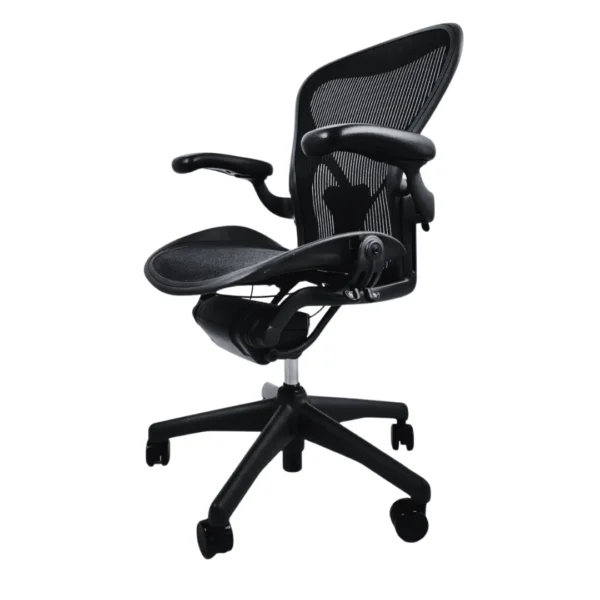As the modern workplace continues to evolve, so too does the furniture designed to support it. Ergonomic office chairs, such as the Herman Miller Aeron Drafting Chair, are at the forefront of this transformation, reflecting broader trends in office seating that prioritize health, flexibility, and aesthetic appeal. In this article, we’ll explore the future of office seating and the trends shaping ergonomic furniture, with a focus on the innovative features of the Herman Miller Aeron Drafting Chair.
1. The Shift Towards Holistic Ergonomics
The traditional approach to ergonomic furniture focused primarily on comfort and support. However, the future of office seating is shifting towards a more holistic understanding of ergonomics that encompasses overall well-being. This includes not just physical comfort, but also mental health, productivity, and environmental sustainability.
Key aspects of holistic ergonomics include:
- Support for Dynamic Movement: Modern ergonomic chairs are designed to accommodate various postures and movements throughout the day. The Herman Miller Aeron Drafting Chair, for example, offers a range of adjustments to support dynamic sitting and standing positions, helping users stay comfortable and focused.
- Mental and Emotional Wellness: Ergonomic chairs are increasingly being designed to contribute to mental well-being by creating a pleasant and stress-free work environment. This includes features that reduce discomfort and enhance focus, such as the headrest and lumbar support of the Aeron Drafting Chair.
- Sustainability: The future of office furniture includes a strong emphasis on environmental responsibility. Herman Miller’s commitment to sustainability is reflected in the Aeron Drafting Chair’s use of recycled materials and its long lifespan, reducing the need for frequent replacements.
2. Heightened Customization and Adaptability
As work environments become more diverse, the need for highly customizable office furniture is growing. Ergonomic chairs are increasingly designed to be adaptable to individual needs and preferences, ensuring that each user can create their ideal workspace.
Customization trends in office seating include:
- Adjustable Features: The Herman Miller Aeron Drafting Chair exemplifies this trend with its extensive range of adjustable features, including seat height, tilt, and lumbar support. This adaptability allows users to fine-tune their chair to support various tasks and postures.
- Modular Design: Future office chairs may incorporate modular components that allow users to add or remove features based on their needs. This could include detachable armrests, footrests, or additional support elements.
- Smart Technology Integration: The integration of smart technology in office furniture is on the rise. Future ergonomic chairs may include sensors and software to monitor posture, provide real-time feedback, and adjust settings automatically to optimize comfort and support.
3. Enhanced Focus on Aesthetics
Office furniture is no longer just about functionality; it’s also about style and design. As workplaces strive to create inspiring and attractive environments, the aesthetic appeal of ergonomic chairs has become increasingly important.
Trends in office chair aesthetics include:
- Minimalist Designs: Clean lines, neutral colors, and simple shapes are becoming popular in office seating. The Herman Miller Aeron Drafting Chair’s sleek, modern design fits perfectly into this trend, offering both functionality and visual appeal.
- Customizable Finishes: Many ergonomic chairs now offer customizable finishes, including various upholstery options and color choices. This allows users to match their chair to their office decor or personal style.
- Design Collaboration: Collaboration between designers and ergonomists is leading to innovative chair designs that balance aesthetics with ergonomics. Herman Miller’s Aeron Drafting Chair is a prime example of this synergy, combining cutting-edge design with advanced ergonomic features.
4. Integration with Flexible Workspaces
The rise of flexible and remote work arrangements is reshaping the design of office furniture. Chairs are increasingly being designed to support various work setups, from traditional desks to standing desks and collaborative workstations.
Key trends in flexible workspace seating include:
- Versatility: The Herman Miller Aeron Drafting Chair is designed to accommodate a range of work environments, including standing desks and high work surfaces. Its height-adjustable design and supportive features make it suitable for various tasks and settings.
- Space Efficiency: As offices become more adaptable and compact, there is a growing need for furniture that maximizes space without sacrificing comfort. Ergonomic chairs that offer compact designs or easy adjustability are ideal for these environments.
- Collaboration-Friendly Features: In collaborative workspaces, chairs are being designed to facilitate easy movement and interaction. Features like swivel bases and mobility enhance the ability to shift between tasks and work closely with colleagues.
5. The Rise of Biophilic Design
Biophilic design, which integrates natural elements into the workspace, is becoming a significant trend in office furniture. This approach aims to create environments that reduce stress and improve overall well-being.
Biophilic design trends in ergonomic seating include:
- Natural Materials: The use of natural materials such as wood and plant-based fabrics in office chairs is on the rise. These materials not only enhance the chair’s aesthetic appeal but also contribute to a healthier and more pleasant work environment.
- Incorporating Nature: Some ergonomic chairs are being designed with features that mimic natural forms and processes. This can include organic shapes, soothing colors, and materials that evoke a connection to nature.
- Enhanced Airflow and Comfort: The Herman Miller Aeron Drafting Chair’s breathable mesh material is an example of how furniture design can contribute to a more natural and comfortable workspace. This feature helps regulate temperature and improve air circulation, aligning with biophilic design principles.
Conclusion
The future of office seating is being shaped by trends that emphasize holistic ergonomics, customization, aesthetics, flexibility, and biophilic design. The Herman Miller Aeron Drafting Chair embodies many of these trends, offering a blend of advanced ergonomic features, stylish design, and adaptability for various work environments.
As workplaces continue to evolve, investing in ergonomic furniture that aligns with these trends will not only enhance comfort and productivity but also contribute to a more sustainable and inspiring work environment. By staying informed about the latest trends and choosing high-quality ergonomic chairs, you can create a workspace that supports your well-being and meets the demands of the modern workday.




